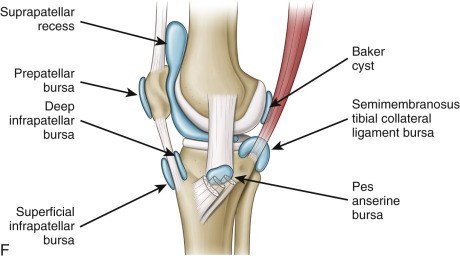BURSITIS
- Retrain Health
- Dec 31, 2020
- 3 min read
First thing is first, what is a bursa?
Chances are, that you have heard of bursae, but what are they, and why do we have them?
Bursa are small fluid filled sacs, that help cushion both the tendons, and ligaments, near your joints.
We have more than 150 bursa, located throughout the body. Some areas you may already be familiar with, which include the knee, elbow, shoulder, and hips (see images above).
The key role of a bursa is to reduce the friction on bones/ joints, caused by tendons and muscles, and allow for these structures to slide and glide past one another with ease.
When a bursa becomes inflamed, it can develop into a condition called bursitis, which can cause pain, restriction and occasionally, swelling.
Pathology:

When bursa become inflamed, the lining can become thickened, the bursae may produce excessive fluid, which can lead to localised swelling, pain and restriction in movement of the associated joint.
Acute bursitis, is inflammation of the bursae, which is less than 6 weeks in duration, and is generally associated with intense, sharp pain, swelling and loss of particular movements.
Chronic bursitis, is when the above changes have been present for more than 6 weeks. Chronic bursitis can often lead to weakness and degeneration of the overlying ligaments, tendons and adjacent muscles. Due to this, tendonitis commonly occurs, in addition to the original bursitis.
Why does it happen?
Bursitis can develop as a result of:
Repetitive activities causing continued friction over the bursa
Trauma or direct force toward the bursa
Continued pressure placed directly on the bursa
How to tell if you have bursitis:
If you believe you may have bursitis, it is a good idea to see your local primary health care practitioner (e.g. osteopath or GP) who will take a thorough history, and perform an assessment, to determine if your discomfort may be as a result of an irritated bursa.
Additionally, your practitioner may also ask you to get an ultrasound to confirm the diagnosis.
While imaging is not always required for diagnosis, it may be used to confirm the location, extent, and progression of the condition, as well as look at other structures surrounding the bursa, which may be contributing to, or effected by, the discomfort.
How long will I have it for?
So, you have been told you have bursitis, how long is it going to last?
The length of time it takes to resolve will depend on the cause, and the extent of the pathology.
For most cases, once treatment has commenced, and provided the cause of the irritation is addressed, resolution will happen within a matter of weeks. More severe cases, particularly those where the pain has already been present for months, to years, or where the aggravating factors can not be avoided, can last for several months.
In either case, the sooner you get onto addressing the pain, the better your outcome should be.
How is it treated?
Initial treatment revolves around reducing inflammation of the bursa.
What you can do at home to help is use anti-inflammatories, reduce activities and movements that aggravate the area, and apply ice when particularly painful.
In addition to what you are doing at home, your osteopath will also be able to help you by reducing the tension within the surrounding muscles, providing joint mobilisation to help reduce the amount of stress and friction that is put on to the bursa.
At Retrain Health, once the inflammation has been managed, we like to shift focus to address the factors we believe will help prevent the bursitis from reoccurring. This may be done with treatment and exercise.
While most people will be able to resolve their bursitis with a combination of self-management and manual therapy, in severe and stubborn cases, the use of corticosteroid injections may be required. Cortisone is a strong anti-inflammatory and may help to reduce the swelling of the bursa, leading to a reduction of pain, and a window of opportunity to strengthen, and improve resilience of the affected area.
If you would like any further information about what bursitis is or how it can be treated, you can call us at Retrain Health on (02) 6680 7447 or book online at www.retrainhealth.com

Retrain Health is based in the Northern Rivers, NSW. From our Byron Bay and Ballina clinics, our team provides a range of quality healthcare services and products.
Retrain Health offers osteopathy, remedial massage and strength and conditioning sessions with qualified practitioners.
If you are interested in finding out more information or would like to book an appointment, please contact the clinic by phone (02) 6680 7447, send us an email or click here to book an appointment online.









Comments